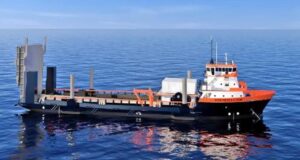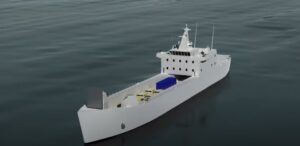The Marine Corps Warfighting Lab (MCWL) is planning to start four stages of experimentation with the prototype landing ship this year, an official said last week.
The Marine Corps has contracted with Hornbeck Offshore Services
[HOS] to modify a commercial Offshore Support Vessel (OSV) into a Stern Landing Vessel (SLV) to help experiment with the concept of the service’s future Landing Ship Medium (LSM), previously called the Light Amphibious Warship. The first of three SLVs is due to be delivered to the government this month.

The LSVs are initially planned to be leased for several years each, but the contracts include options for the government to buy them.
Lt. Col. Tim Smith, MCWL science and technology logistics combat element branch head, said the Navy and Marine Corps experimentation with the SLV will go through four phases, starting with a 12-week limited technical analysis.
“That initial piece that we’re going to do is…we’re going to find out like, how does the SLV actually work in some benign conditions, with the graduation exercise, obviously going to a no kidding surf, in the ocean, how does it actually work. Do we have to use jacking legs? What’s the impact to the beaches that we’re working? What is the impact of the ramp? Does it really do everything it says it’s going to do? So that’s what we’re going to learn in our first 12-week test period,” Smith told reporters on Feb. 27.
The first SLV will feature a 12-foot draft, 6,000 square feet of cargo space, the capacity to hold 38 Marines and 12-15 commercial mariners, a large ramp, several landing skegs and other material to protect the rear ship rudder and prop area, and landing legs for stability (Defense Daily, March 1).
The final LSM is planned to hold 75 Marines each, with nine LSMs needed to field one of three total Marine Littoral Regiments. The Navy and Marine Corps foresee 35 total LSM-type ships, which allows the 27 ships needed to move an MLR plus extras for normal ship maintenance schedules.
Smith added the lab aims to test loading and unloading most of the vehicles in the Marine Corps inventory on and off the SLV’s rear ramp, heading off any potential problems.
“We’re not anticipating issues, but you never know when you’re doing something for the first time. So, hence, a lot of the experimentation solely focused at MCWL. We’re not giving this right away to the operational forces for them to do what they want with it,” Smith said.
He noted they are currently creating the initial manuals that will govern how the Navy-Marine Corps team uses the vessel, but they also expect to refine them multipole times over the test and evaluation process.
Smith said once they deem the SLV is safe to operate it will transfer to the experiments division of MCWL “and we will start doing some limited things with the fleet.”
Once the lab verifies the SLV is safe to operate and they finish the first set of experiments based out of Quantico, Va., the ship will travel to California to do some work in the Indo-Pacific Command theater, “then likely move to Hawaii for some additional testing and analysis,” he continued.
After the ship travels to Hawaii, “it’s going to definitely be heavy in future MLR experimentation, different mobility and logistics assessments. We’re going to develop and refine a lot of concepts of employment, tactics, techniques and procedures, so that was phase two,” Smith said.

The third phase of experimentation will focus on “continued MLR and fleet use, and then how does that really nest, potentially, with other larger pieces of what the Navy-Marine Corps team wants to do with it.”
Finally, Smith said in phase four the MCWL wants to experiment with the ship with joint operations.
“So between the fleet and our other joint partners, how does that integrate well, does it play well with Army vehicles? Does it play well with potential Air Force use, etc.”
The second and third SLVs will have the same basic capabilities as the first ship, but they may not look very similar as the Marine Corps learns from this initial experimentation. The MCWL expects to receive those vessels in 2024.
The Marine Corps plans to use the normal contracting process, via Military Sealift Command, for those vessels and Smith said there is no guarantee HOS will win them too.